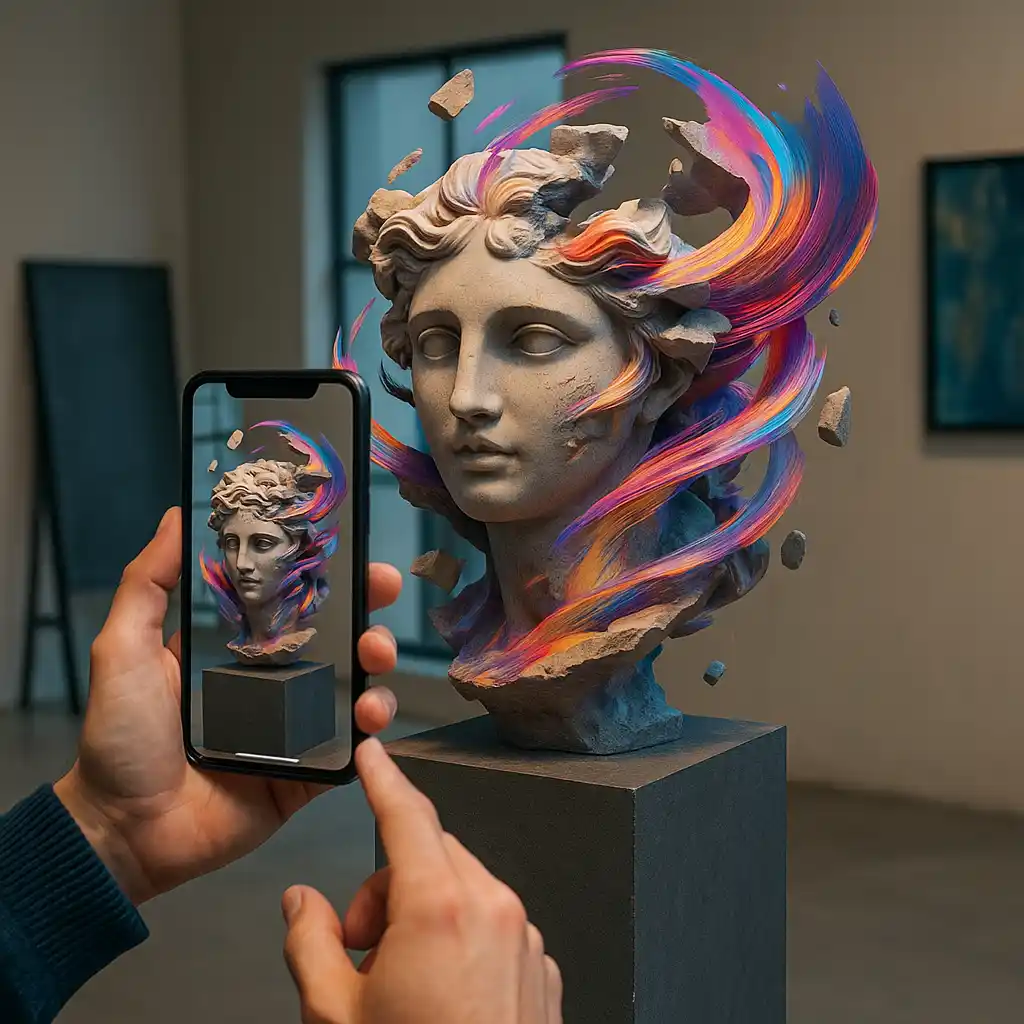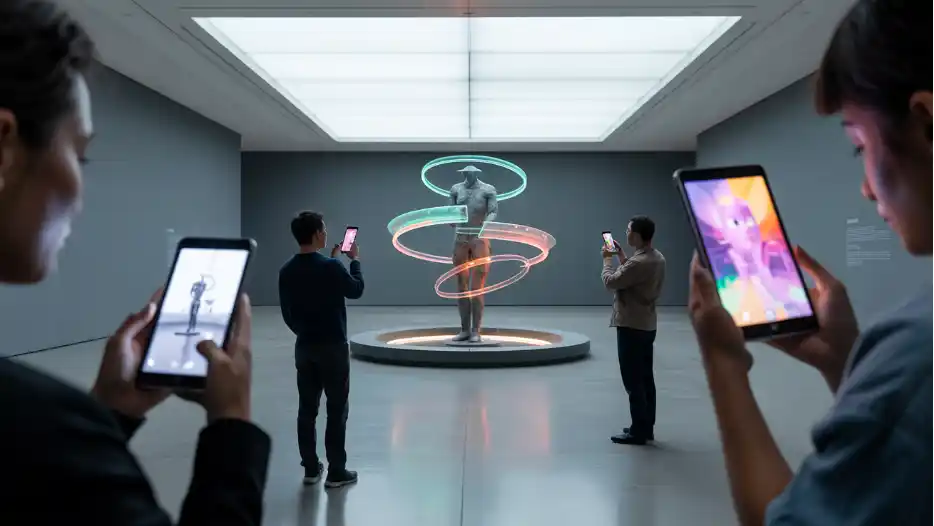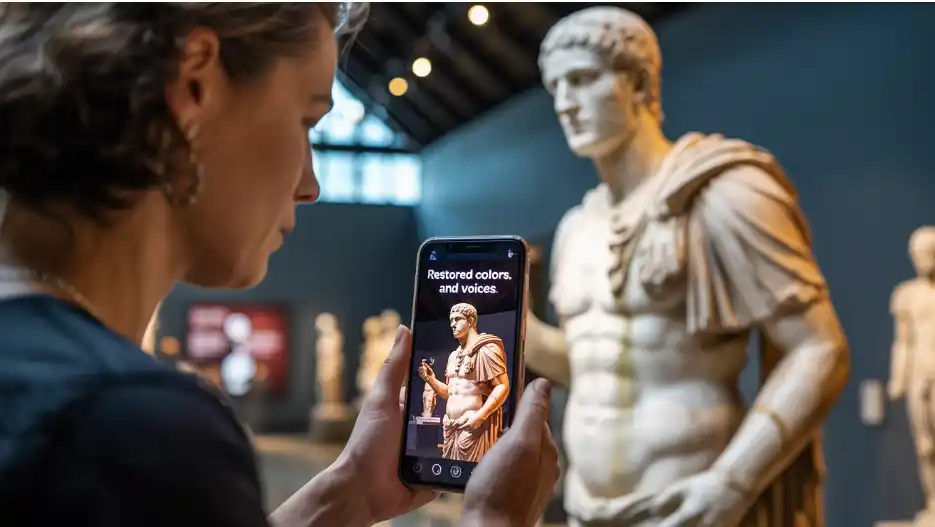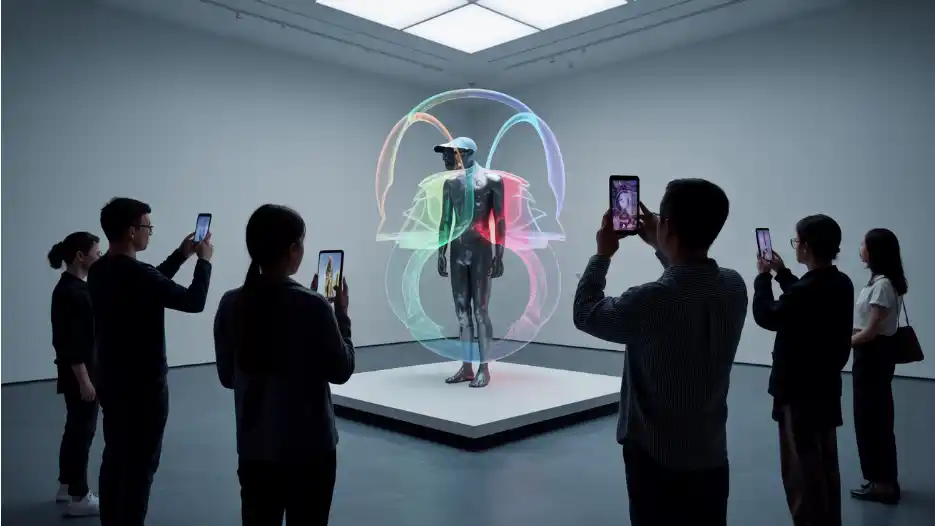Through the passage of time, art has continuously developed its form. Art has evolved throughout history from cave paintings through Renaissance masterpieces to abstract installations and digital media before arriving at augmented reality art today. The world now experiences an exciting shift through augmented reality art (AR art). The creative process now involves merging digital visuals with physical sculptures to produce immersive art experiences that transcend traditional materials like paint or clay.
A sculpture becomes responsive through phone viewing by displaying color transformations while telling stories during viewer movement. This concept has transitioned from science fiction into augmented reality drawings. Through its rising popularity, art as technology and its fusion with AR sculpture continue to transform our artistic encounters and creative processes. The following article describes the nature of augmented reality art together with its application in sculpture and outlines its projected future artwork directions.
AR technology art enables artists to integrate digital elements , including sound and motion , and animation, into physical artworks for creating augmented reality art. Through smartphones and tablets , and AR glasses, viewers can experience digital content that overlays physical objects in the real world. So, what is reality art ? Art can coexist between the physical world and the digital realm according to this concept. Through an app, viewers discover concealed animations together with hidden messages that appear in addition to the original painting augmented reality
One standout example of augmented reality sculpture is the Art in Pearl installation, which blends digital storytelling with physical structures to create a fully immersive public experience. AR artworks generate a unique level of viewer involvement because of their interactive nature. The viewer transitions from being a passive observer into an active participant who can influence their art experience through movement and interaction.
Traditional sculpture is all about form, material, and space. That form should react when people enter the space. Or the material could shift with light and time? The union of sculpture and augmented reality technology creates new possibilities.
This blend opens up endless possibilities. AR doesn’t destroy sculpture, yet it makes it better. People still experience the tangible artwork, but now they can engage with a digital emotional component that intensifies their connection with the artwork. Sculpture painting, augmented reality are emerging as a popular practice that uses digital painting on 3D models that AR apps display. The artistic creation is still present, but with enhanced smart interactive capabilities.
AR installations have become a common practice for museums and galleries as well as public areas that use sculpture alongside augmented reality. With these installations, visitors can participate in an anywhere reality artwork instead of watching it passively.
AR technology allows artists to display multiple layers of meaning and message , and motion within one area without increasing the physical space requirements. This technology represents a transformative power for public installations and technological art.
AR technology has gained popularity, which has led to the rise of artists who use its capabilities to transform existing artistic limits. Several artists led the development of this field, so let’s examine their contributions.
The rising AR sculptor who goes by ar cooke has gained social media popularity through his human form sculptures in surreal environments.
Several artist, among many others, use their innovative approaches to establish the direction of upcoming artwork.
Future artwork, development of sculpture, and AR collaboration will continue to advance with more creative approaches. The following trends are worth monitoring:
The Apple Vision Pro and Meta Quest devices enable users to access AR experiences while their hands remain free from holding phones. The technology provides an authentic and deep immersion during sculpture interactions.
AI tools now assist artists in creating dynamic AR experiences through their practice. A sculpture would modify its digital appearance through your emotional state and facial expressions, and spoken words.
The digital AR sculpture market merges with physical art through NFT ownership, which allows buying and selling. New revenue streams emerge for creators through this combination.
The digital platform enables artists to position their sculptures in multiple locations across the world. Viewers need only an application to experience artwork since this method provides greater accessibility to art.
The increasing number of reality art participants will fuel greater demand for dynamic interactive art experiences.
Artists who want to explore AR technology should familiarize themselves with the different augmented reality categories.
A physical image or code needs to exist to activate the digital content. Great for printed sculptures or art catalogs.
Digital objects get placed at real-world sites through GPS technology. The most suitable application for outdoor installations and public art exists.
A projection system displays digital light on physical surfaces, which converts any sculpture into an interactive display.
The system replaces the original view section with an enhanced digital view. The technology enables users to add historical content to existing ancient structures and statues.
This advanced AR system creates real-time maps of surrounding environments. Digital sculptures can be precisely positioned within any environment using this technology.
These categories enable artists to select appropriate methods to implement their AR visions.
The combination of sculpture with AR technology enables us to experience a fresh art revolution. In this process, we go beyond simply implementing a digital filter or effect. Perhaps time anxiety relieved the issue. Art transforms to shift from passive observation to active participation while transitioning from static objects to moving entities.
The technology behind reality art drawings , sculptures, and immersive AR artworks has already transitioned from conceptual to reality. The artists who unite art with technology create the innovative artistic movement of the future. People interested in new experiences , along with artists and collectors, should explore reality art opportunities at present time.
Through AR and AI and 3D printing , and VR, artists now possess new digital tools that extend their creative possibilities. The artworks of artists gain additional elements through the integration of motion and sound and interaction, and data. Through online exhibitions and AR installations, artists can use technology to connect their artwork with global audiences.
Augmented reality art combines digital content with real-world environments by adding virtual layers to physical spaces. Through AR glasses or apps, viewers can experience digital animations and sound effects and digital layers that appear on top of physical artwork, including sculptures , paintings, and spaces.
AR provides better accessibility than VR because it does not require full headset immersion and works well in public areas. The technology enables simple sharing and seamless integration with traditional artistic forms , including sculpture and painting.





